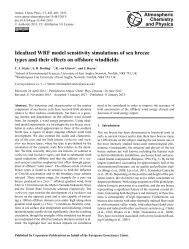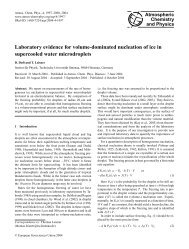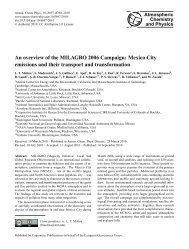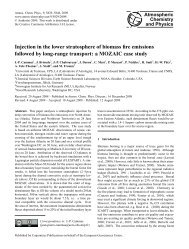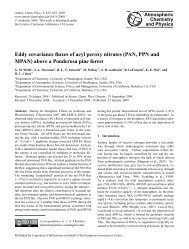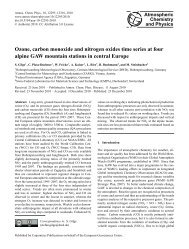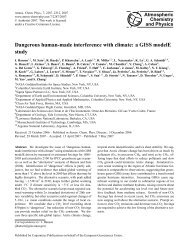A modified band approach for the accurate calculation of online ...
A modified band approach for the accurate calculation of online ...
A modified band approach for the accurate calculation of online ...
Create successful ePaper yourself
Turn your PDF publications into a flip-book with our unique Google optimized e-Paper software.
4156 J. E.Williams et al.: Online photolysis in Chemical Transport Models<br />
shadowing effect <strong>of</strong> <strong>the</strong> earth begins to reduce <strong>the</strong> Fabs component<br />
to such an extent that <strong>the</strong> application <strong>of</strong> limits to <strong>the</strong><br />
scaling ratio is needed. This subsequently introduces larger<br />
errors <strong>of</strong> between 10–30% at 20–30 km. Moreover, <strong>the</strong> application<br />
<strong>of</strong> grid B leads to a substantial reduction in <strong>the</strong> associated<br />
errors compared to J values calculated with both<br />
<strong>the</strong> original grid and grid A (not shown). Although it is possible<br />
to calculate J values with PIFM-PS up to an incident<br />
zenith angle <strong>of</strong> 95 ◦ (see Sect. 3.2), <strong>the</strong> small values <strong>of</strong> both<br />
Fact and Fabs result in large errors being introduced at angles<br />
above θ=93 ◦ <strong>for</strong> similar reasons to those discussed above. In<br />
fact, a significant degradation in <strong>the</strong> per<strong>for</strong>mance can be seen<br />
<strong>for</strong> θ>92.5 ◦ , suggesting this limit should be applied <strong>online</strong>.<br />
Moreover, many <strong>of</strong> <strong>the</strong> J values become so small under such<br />
conditions that <strong>the</strong> computational expense <strong>of</strong> per<strong>for</strong>ming <strong>the</strong><br />
<strong>calculation</strong> is <strong>of</strong>ten not warranted.<br />
4.2 Clear-sky with tropospheric aerosol<br />
In global CTMs clear-sky conditions almost never exist due<br />
to <strong>the</strong> ubiquitous presence <strong>of</strong> aerosols, liquid water clouds<br />
and ice water clouds (with <strong>the</strong> cloud fraction, liquid water<br />
content and ice water content usually being defined by <strong>the</strong><br />
meteorological input data). The effect <strong>of</strong> both clouds and<br />
aerosol on atmospheric processes via <strong>the</strong> perturbation <strong>of</strong> <strong>the</strong><br />
radiation field has been extensively discussed in <strong>the</strong> literature<br />
(e.g. He and Carmichael, 1999; Haywood and Boucher,<br />
2000; Tie et al., 2004). Here we investigate <strong>the</strong> effects that<br />
aerosol particles have on <strong>the</strong> error budgets associated with<br />
<strong>the</strong> J values calculated with <strong>the</strong> <strong>modified</strong> <strong>band</strong> <strong>approach</strong>. For<br />
brevity we only present <strong>the</strong> results calculated using grid A <strong>for</strong><br />
a few species selected from <strong>the</strong> tropospheric subset, which<br />
are thought to be <strong>the</strong> most sensitive. The simulations are<br />
per<strong>for</strong>med using rural aerosol <strong>for</strong> <strong>the</strong> lowest 4km and ‘background’<br />
aerosol <strong>for</strong> <strong>the</strong> rest <strong>of</strong> <strong>the</strong> model atmosphere. The<br />
particle number density <strong>of</strong> each layer was scaled such that<br />
<strong>the</strong> integrated optical depth due to <strong>the</strong> aerosol column was<br />
0.32 at 550 nm, in line with <strong>the</strong> settings chosen in Landgraf<br />
and Crutzen (1998). Figure 14 shows <strong>the</strong> effect <strong>of</strong> aerosol<br />
loading on <strong>the</strong> error budgets associated with <strong>the</strong> J value pr<strong>of</strong>iles<br />
calculated <strong>for</strong> O3→O 1 D, (b) HNO3, (c) HNO4 and (d)<br />
HCOH. For this purpose comparisons are made against J<br />
value pr<strong>of</strong>iles calculated using reference model B. Comparing<br />
<strong>the</strong>se contour plots with <strong>the</strong> corresponding plots given in<br />
Fig. 12 shows that <strong>the</strong> contouring is approximately <strong>the</strong> same<br />
<strong>for</strong> <strong>the</strong>se chemical species. There<strong>for</strong>e, <strong>the</strong> additional absorption<br />
and scattering introduced by tropospheric aerosol does<br />
not result in any significant degradation in <strong>the</strong> per<strong>for</strong>mance<br />
<strong>of</strong> <strong>the</strong> <strong>modified</strong> <strong>band</strong> <strong>approach</strong>.<br />
For <strong>the</strong> “urban” aerosol, as defined by Shettle and Fenn<br />
(1979), which exhibits a higher absorption component than<br />
<strong>the</strong> “rural” aerosol, <strong>the</strong>re is a larger reduction in <strong>the</strong> J values<br />
<strong>for</strong> <strong>the</strong> bottom layers compared to those obtained using<br />
“rural” aerosol (not shown). However, <strong>the</strong> effect on <strong>the</strong> error<br />
budgets is again minimal, meaning that no significant differences<br />
exist compared to <strong>the</strong> error contours shown in Fig. 14.<br />
4.3 Cloudy atmosphere<br />
The final analysis presented in this paper focuses on effects<br />
<strong>of</strong> cloud on <strong>the</strong> error budget <strong>of</strong> <strong>the</strong> <strong>modified</strong> <strong>band</strong> <strong>approach</strong>.<br />
For this purpose we consider a model atmosphere with two<br />
cloud layers each having 100% cloud coverage at 1–2 km<br />
and 7–8 km with optical densities <strong>of</strong> 24.9 and 38.3, respectively.<br />
The aerosol loading is prescribed as in Sect. 4.2 but<br />
we assume that <strong>the</strong> relative humidity within <strong>the</strong> cloud layers<br />
is near saturation (98%). Due to <strong>the</strong> increase in relative humidity<br />
in <strong>the</strong> cloud layer <strong>the</strong> aerosol optical depth increases<br />
to 0.52 at 550 nm. Such conditions pertain to <strong>the</strong> type <strong>of</strong><br />
scenarios commonly encountered in a CTM. For <strong>the</strong> tropospheric<br />
species <strong>the</strong> effect <strong>of</strong> cloud on <strong>the</strong> J values is similar<br />
to that shown in Landgraf and Crutzen (1998), and is briefly<br />
summarized here. The attenuation <strong>of</strong> light directly above <strong>the</strong><br />
highest cloud layer (at 7–8 km) causes a substantial increase<br />
in <strong>the</strong> magnitude <strong>of</strong> <strong>the</strong> J values at <strong>the</strong> cloud top (∼50%).<br />
This amplification gradually disappears with altitude until<br />
<strong>the</strong> J values are approximately equal to clear sky conditions<br />
at ∼20 km altitude. There is a corresponding decrease directly<br />
below <strong>the</strong> cloud layer (∼20%), which again gradually<br />
disappears at altitudes <strong>of</strong> 2–3 km. The lower cloud layer effectively<br />
screens <strong>the</strong> lowest layers resulting in decreases in<br />
<strong>the</strong> certain J values <strong>of</strong> upto ∼80%. Those species which<br />
absorb below λ85 ◦<br />
clear-sky conditions are assumed in PIFM-PS during <strong>the</strong> RT<br />
<strong>calculation</strong>s due to <strong>the</strong> numerical instability introduced in <strong>the</strong><br />
lower layers <strong>for</strong> combinations <strong>of</strong> long slant paths and layers<br />
with high optical depths due to abnormally high τslant values.<br />
Figure 16 shows <strong>the</strong> corresponding results <strong>for</strong> <strong>the</strong> stratospheric<br />
species included in Fig. 11. Comparison <strong>of</strong> <strong>the</strong>se<br />
plots shows that <strong>the</strong> effect <strong>of</strong> <strong>the</strong> increase in upwelling radiation<br />
is ra<strong>the</strong>r insignificant. However, it should be noted<br />
that <strong>the</strong> J values <strong>for</strong> more sensitive species (e.g. NO2) can<br />
be altered by this effect (not shown).<br />
In summary, no significant degradation in <strong>the</strong> accuracy <strong>of</strong><br />
<strong>the</strong> <strong>band</strong> method occurs <strong>for</strong> cloudy conditions <strong>for</strong> chemical<br />
Atmos. Chem. Phys., 6, 4137–4161, 2006 www.atmos-chem-phys.net/6/4137/2006/



